A lot of things are different this year. With the changes come opportunities to try something new. Liz Brownlee with Hoosier Young Farmers Coalition mentioned to me that some markets, especially in rural areas, do not have a steady supply of Fall crops, and that farmers might be looking to extend the season with crops not grown before. Many Indiana vegetable farms thrive on the warm season crops planted in spring: tomatoes, peppers, cantaloupe, watermelon, squash, pumpkins, sweet corn. But cool season crops planted in late summer are also grown and marketed successfully at farmers’ markets and to other outlets like food hubs and online marketplaces. For those new to these crops and thinking about trying them, this is a reminder that it’s not too late to plant some crops for fall harvest. (Figures 1 and 2).
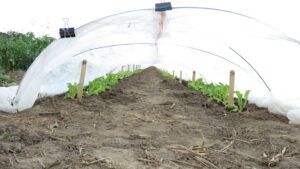
Figure 1. Newly transplanted leaf lettuce under a low tunnel with lightweight row cover to protect from deer, Sept. 20, 2018. Lettuce was seeded in greenhouse on Aug. 21. Pinney Purdue Ag Center, Wanatah, IN.
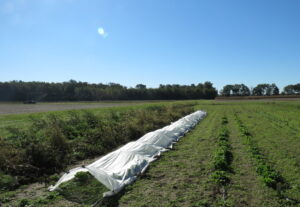
Figure 2. Lettuce transplanted Sept. 13 (right) and Sept. 20 (under row cover) ready for a second harvest on Oct. 18. Smaller heads were harvested a week earlier. Pinney Purdue Ag Center, Wanatah, IN.
Lettuce, spinach, kale and many other greens in the brassica family (mustards, mizuna, tatsoi, bok choy), as well as radishes and turnips can be direct-seeded or transplanted in the field, under low tunnels, and in unheated or minimally heated high tunnels. Spinach and kale are the most cold-hardy and likely to maintain production into winter in unheated tunnels or outside under row cover.
Planted in late summer, many of the leafy crops will be ready for a first harvest of baby leaves within 3 or 4 weeks of seeding, and multiple harvests are possible. For a full lettuce head or harvest of large kale leaves it can take about 4 weeks from transplanting, depending on the variety. Radishes can be ready to harvest in 3.5 to 4 weeks from seeding. With later plantings the days to harvest increase as temperatures drop and day length and sunshine decrease; what was a 30-day crop in early September can become a 40 to 50-day crop when planted in mid-October. Later plantings may not be ready to harvest until after the new year. Tables 1 and 2 illustrate this with examples from Indiana farms located north of I-70. Note that the latest plantings were often in minimally-heated high tunnels, meaning they were kept above about 28°-30°F.
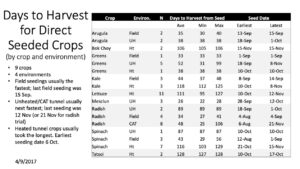
Table 1. Days to harvest and seeding dates for direct-seeded crops in field, caterpillar tunnel (CAT), unheated high tunnel (UH) and minimally-heated high tunnel (Ht) for several Indiana farms in 2016. N indicates the number of plantings summarized for that crop and location.
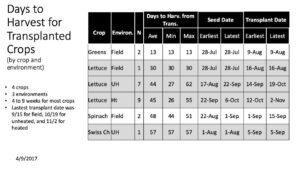
Table 2. Days to harvest, seed, and transplant dates for some transplanted crops in field, unheated high tunnel (UH) and minimally heated high tunnel (Ht) for several Indiana farms in 2016.
While examples from other farms are helpful, records from your own farm are essential for tailoring schedules to your operation. In the project where we collected the data above we found a practical way to record information for each planting was to place large wooden marker at each planting and use a marker pen to record variety, seed, plant, and harvest dates, as well as yield on each harvest date (Figure 3). After the final harvest information could be transferred to a computer spreadsheet or other permanent record. Of course, that is just one means of recordkeeping—the important thing is to keep the records in some manner, and then take time to review them.
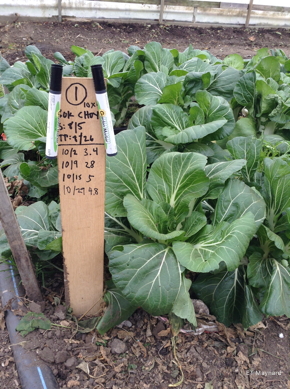
Figure 3. Wooden stake used to record seed (S), transplant (TP), and harvest dates, and yield at each harvest, for bok choy in a minimally heated high tunnel.
Many fall crops are grown at the Purdue Student Farm in West Lafayette. Farm manager Chris Adair shared some of the varieties that work well for them:
Kale
These varieties are good for large leaves picked as they reach size, starting from the bottom of the plant.
- Winterbor
- Fantastic growing kale with great disease resistance and high frost tolerance, pests do not like as much, so lower incidences of imported cabbage worm, but it can still be in large enough numbers to ruin the crop
- Scarlet
- Similar to Winterbor in shape but a red to purplish color, highly productive but is a bit susceptible to bacterial diseases that can get into the leaf or stem; still seems to be less susceptible than other varieties
- Toscano
- Also known as dinosaur kale, is very productive and fairly tasty for a large leaved version but is a preferred kale by imported cabbage worm, so have to be extra careful to manage the worms or they will eat it to nothing. At student farm we spray Bt or Spinosad.
This variety is good for baby kale that can be used in salads.
- Red Russian
- Great tasting kale especially after a frost, not the best to pick for large leaves so we use it for baby kale which is planted in tightly packed rows to keep leaves small
Lettuce
Have really moved to only multi-leaf lettuce varieties (e.g. Salanova™) as they are very versatile and easy to work with, never had any disease issues, the red types seem to handle the frost better than the greens but, overall are quite frost hardy.
- Butter Type
- Good tasty lettuce with smaller leaves with the green butter being really nice
- Oakleaf Type
- Great looking shape that tends to stay small enough for salads, both red and green grow well in the field and can be very productive
- Incised Type
- Much larger leaved and as a whole plant compared to the others, a bit crunchier stem as well which is nice
Broccoli
- Gypsy
- Pretty solid broccoli that if treated correctly will produce even in warmer temperatures, ours at the farm put on heads in mid-July even with all the previous 90+ degree days
Beets
Not too many pest issues but burrowing rodents will eat on the roots and deer love the beet greens.
- Red Ace
- Good productive standard beet, can get very large without being too corky or tough in the middle
- Chioggia
- A good non-red beet that is generally pretty productive but not nearly as good as the red ace
Radish
- Rover
- Good standard radish that does exactly what you want it to, minimal pest issues other than some flea beetles loving the leaves but they will grow through it
- D’Avignon
- Nice long skinny radish that has good flavor and quite productive as well, same issues as Rover with the flea beetles
Cabbage
- Tiara
- A good smaller-headed cabbage that tends to produce well but will get bacterial rots
Turnip
- Purple Top
- Good productive turnip that can be harvested small or large without too many issues of corkiness when they are large